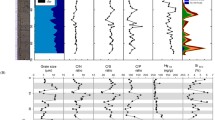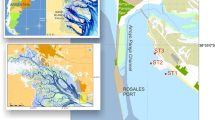Abstract
Nontronite and microbes were detected in the surface layers of deep-sea sediments from Iheya Basin, Okinawa Trough, Japan. Nontronite, an Fe-rich smectite mineral, was embedded in acidic polysaccharides that were exuded by microbial cells and electron microscopy showed that the nontronite layers were apparently oriented in the polysaccharide materials. We propose that the formation of nontronite was induced by the accumulation of Si and Fe ions from the ambient seawater and that extracellular polymeric substances (EPS) served as a template for layer-silicate synthesis. Experimental evidence for this hypothesis was obtained by mixing a solution of polysaccharides (dextrin and pectin) with ferrosil-iceous groundwater. After stirring the mixture in a sealed vessel for two days, and centrifuging, Fe-rich layer silicates were identified within the precipitate of both the dextrin and pectin aggregates, whereas rod-shaped or spheroidal Si-bearing iron hydroxides were found in the external solution. Microbial polysaccharides would appear to have affected layer-silicate formation.
Similar content being viewed by others
References
Aizenberg, J., Black, A. J. and Whitesides, G. M. (1999) Control of crystal nucleation by patterned self-assembled monolayers. Nature, 398, 495–498.
Akai, J., Akai, K., Ito, M., Nakano, S., Maki, Y. and Sasa-gawa, I. (1999) Biologically induced iron ore at Gunma iron mine, Japan. American Mineralogist, 84, 171–182.
Badaut, D., Decarreau, A. and Besson, G. (1992) Ferri-pyrophyllite and related Fe3+-rich 2:1 clays in recent deposits of Atlantis II Deep, Red Sea. Clay Minerals, 27, 227–244.
Barker, W. W. and Banfield, J. F. (1996) Biologically versus inorganically mediated weathering reactions: relationships between minerals and extracellular microbial polymers in lithobiontis communities. Chemical Geology, 132, 55–69.
Barker, W. W., Welch, S. A. and Banfield, J. F. (1997) Geomi-crobiology of silicate mineral weathering. Pp. 391–428 in: Geomicrobiology: Interactions between Microbes and Minerals (J. F. Banfield and K. H. Nealson, editors). Reviews in Mineralogy, 35. Mineralogical Society of America, Washington, D.C.
Barker, W. W., Welch, S. A., Chu, S. and Banfield, J. F. (1998) Experimental observation of the effect of bacteria on alu-minosilicate weathering. American Mineralogist, 83, 1551–1563.
Beveridge, T. J. (1989) The structure of bacteria. Pp. 1–65 in: Bacteria in Nature: a Treatise on the Interaction of Bacteria and their Habitats (E. R. Leadbetter. and J. S. Poidex-ter, editors). Plenum, New York.
Cole, T. G. and Shaw, H. F. (1983) The nature and origin of authigenic smectites in some recent marine sediments. Clay Minerals, 18, 239–252.
Decarreau, A. and Bonnin, D. (1986) Synthesis and crystal-logenesis at low temperature of Fe(III)-smectites by evolution of coprecipitated gels: Experiments in partially reducing conditions. Clay Minerals, 21, 861–877.
Decarreau, A., Bonnin, D., Badaut-Trauth, D., Couty, R. and Kaiser, P. (1987) Synthesis and crystallogenesis of ferric smectite by evolution of Si-Fe coprecipitates in oxidizing conditions. Clay Minerals, 22, 207–223.
Ferris, F. G., Beveridge, T. J. and Fyfe, W. S. (1986) Iron-silica crystallite nucleation by bacteria in a geothermal sediment. Nature, 320, 609–611.
Fisk, M. R., Giovannoni, S. J. and Thorseth, I. H. (1998) Alteration of oceanic volcanic glass: Textural evidence of microbial activity. Science, 281, 978–980.
Fortin, D., Davis, B. and Beveridge, T. J. (1996) Role of Thio-bacillus and sulfate-reducing bacteria in iron biocycling in oxic and acidic mine tailings. FEMS Microbiology Ecology, 21, 11–24.
Fortin, D., Ferris, F. G. and Beveridge, T. J. (1997) Surface-mediated mineral development by bacteria. Pp. 161–180 in: Geomicrobiology: Interactions between Microbes and Minerals (J. F. Banfield and K. H. Nealson, editors). Mineralogical Society of America.
Fortin, D., Ferris, F. G. and Scott, S. D. (1998) Formation of Fe-silicates and Fe-oxides on bacterial surfaces in samples collected near hydrothermal vents on the Southern Explorer Ridge in the northeast Pacific Ocean. American Mineralogist, 83, 1399–1408.
Gamo, T., Ishibashi, J., Sakai, H., Kodera, M., Igarashi, G., Ozima, M., Akagi, T. and Masuda, A. (1987) Geochemistry of hydrothermal solutions in the Okinawa Trough: Report on Dive of the SHINKAI 2000. JAMSTECTR Deepsea Research, 213–224 (in Japanese with an English abstract).
Harder, H. (1976) Nontronite synthesis at low temperatures. Chemical Geology, 18, 169–180.
Harder, H. (1978) Synthesis of iron layer silicate minerals under natural conditions. Clays and Clay Minerals, 26, 65–72.
Hobbie, J. E., Daley, R. J. and Jasper, S. (1977) Use of Nucle-pore Filters for counting bacteria by fluorescence microscopy. Applied and Environmental Microbiology, 33, 1225–1228.
Inoue, K. and Huang, P. M. (1984) Influence of citric acid on the natural formation of imogolite. Nature, 308, 58–60.
Inoue, K. and Huang, R. M. (1990) Perturbation of imogolite formation by humie substances. Soil Science Society of America Journal, 54, 1490–1497.
Jongmans, A. G., van Breemen, N., Lundström, U., van Hees, P. A. W., Finlay, R. D., Srinivasan, M., Unestam, T., Giesler, R., Melkerud, P.-A. and Olsson, M. (1997) Rock-eating fungi. Nature, 389, 682–683.
Juniper, S. K. and Tebo, M. (1995) Microbe-metal interactions and mineral deposition at hydrothermal vents. Pp. 219–253 in: The Microbiology of Deep-sea Hydrothermal Vents (D. M. Karl, editor). CRC Press, New York.
Kimura, M., Uyeda, S., Kato, Y., Tanaka, T., Yamano, M., Gamo, T., Sakai, H., Kato, S., Izawa, E. and Oomori, T. (1988) Active hydrothermal mounds in the Okinawa Trough backarc basin, Japan. Tectonophysics, 145, 319–324.
Köhler, B., Singer, A. and Stoffers, P. (1994) Biogenic nontronite from marine white smoker chimneys. Clays and Clay Minerals, 42, 689–701.
Konhauser, K. O., Fisher, Q. J., Fife, W. S., Longstaffe, F.J. and Powell, M. A. (1998) Authigenic mineralization and detrital clay binding by freshwater biofilms: the Brahmani River, India. Geomicrobiology Journal, 15, 209–222.
Lierman, L. J., Karinowski, B. E., Brantley, S. L. and Ferry, J. G. (2000) Role of bacterial siderophores in dissolution of hornblende. Geochimica et Cosmochimica Acta, 64, 587–602.
Masuda, H. (1995) Iron-rich smectite formation in the hydrothermal sediment of Iheya Basin, Okinawa Trough. Pp. 509–521 in: Biogeochernical Processes and Ocean Flux in the Western Pacific (H. Sakai and Y. Nozaki, editors). Terra Scientific Publishing Company, Tokyo.
Masuda, H., Ishibashi, J., Kato, Y., Gamo, T. and Sakai, H. (1987) Oxygen isotope ratio and trace element composition of hydrothermal sediments from Okinawa Trough, collected with SHINKAI 2000, Dive 231. JAMSTECTR Deepsea Research, 225–231 (in Japanese with an English abstract).
Moore, D. M. and Reynolds, R.C. (1997) X-ray Diffraction and the Identification and Analysis of Clay Minerals. 2nd edition. Oxford University Press, Oxford, New York, 378 pp.
Newman, D. K., Ahmann, D. and Morel, F. M. M. (1998) A brief review of microbial arsenate respiration. Geomicro-biology Journal, 15, 255–268.
Porter, K. G. and Feig, Y. S. (1980) The use of DAPI for identifying and counting aquatic microflora. American Society of Limnology and Oceanography, 25, 943–948.
Schultze-Lam, S., Ferris, F. G., Sherwood-Lollar, B. and Gerits, J. P (1996a) Ultrastructure and seasonal growth patterns of microbial mats in a temperate climate saline-alkaline lake: Goodenough Lake, British Columbia, Canada. Canadian Journal of Microbiology, 42, 147–161.
Schultze-Lam, S., Fortin, D. and Beveridge, T. J. (1996b) Mineralization of bacterial surfaces. Chemical Geology, 132, 171–181.
Schultze-Lam, S., Harauz, G. and Beveridge, T. J. (1992) Participation of a cyanobacterial S-layer in fine-grain mineral formation. Journal of Bacteriology, 174, 7971–7981.
Singer, A. and Stoffers, P. (1987) Mineralogy of a hydrothermal sequence in a core from the Atlantis II Deep, Red Sea. Clay Minerals, 22, 251–267.
Singer, A., Stoffers, P., Hellar-Kallai, L. and Szafranek, D. (1984) Nontronite in a deep sea core from South Pacific. Clays and Clay Minerals, 32, 375–383.
Sleytr, U. B. and Beveridge, T. J. (1999) Bacterial S-layers. Trends in Microbiology, 7, 253–259.
Tashiro, Y. and Tazaki, K. (1999) The primitive stage of microbial mats comprising iron hydroxides. Earth Science, 53, 27–35 (in Japanese with an English abstract).
Tazaki, K. (1997) Biomineralization of layer silicates and hy-drated Fe/Mn oxides in microbial mats: An electron microscopical study. Clays and Clay Minerals, 45, 203–212.
Tazaki, K. (1999) Architecture of biomats reveals history of geo-, aqua-, and bio-systems. Episodes, 22, 21–25.
Theng, B. K. G. and Orchard, V. A. (1995) Interactions of clays with microorganisms and bacterial survival in soil: a phys-icochemical perspective. Pp. 123–143 in: Environmental Impact of Soil Component Interactions-Metals, other Inorganics, and Microbial Activities, Volume II (P. M. Huang, J. Berthelin, J. -M. Bollag, W. B. McGill and A. L. Page, editors). Lewis Publishers, CRC Press, Florida.
Ueshima, M. and Tazaki, K. (1998) Bacterial bioweathering of K-feldspar and biotite in granite. Journal of the Clay Science Society of Japan, 38, 68–82 (in Japanese with an English abstract).
Urrutia, M. M. and Beveridge, T. J. (1993) Mechanism of silicate binding to the bacterial cell wall in Bacillus subtilis. Journal of Bacteriology, 175, 1936–1945.
Urrutia, M. M. and Beveridge, T. J. (1994) Formation of finegrained metal and silicate precipitates on a bacterial surface (Bacillus subtilis). Chemical Geology, 116, 261–280.
Urrutia, M. M. and Beveridge, T. J. (1995) Formation of short-range ordered aluminosilicates in the presence of a bacterial surface (Bacillus subtilis) and organic ligands. Geoderma, 65, 149–165.
Uyeda, S. (1987) Active hydrothermal mounds in the Okinawa back-arc trough. EOS, Transactions American Geophysical Union, 68, 737.
Welch, S. A., Barker, W. W. and Banfield, J. F. (1999) Microbial extracellular polysaccharides and plagioclase dissolution. Geochimica et Cosmochimica Acta, 63, 1405–1419.
Author information
Authors and Affiliations
Rights and permissions
About this article
Cite this article
Ueshima, M., Tazaki, K. Possible Role of Microbial Polysaccharides in Nontronite Formation. Clays Clay Miner. 49, 292–299 (2001). https://doi.org/10.1346/CCMN.2001.0490403
Received:
Revised:
Published:
Issue Date:
DOI: https://doi.org/10.1346/CCMN.2001.0490403




